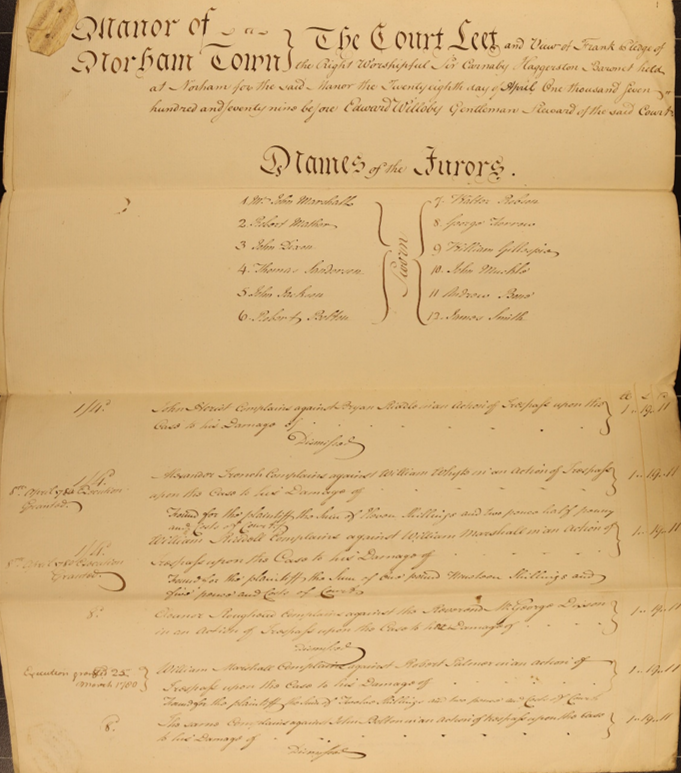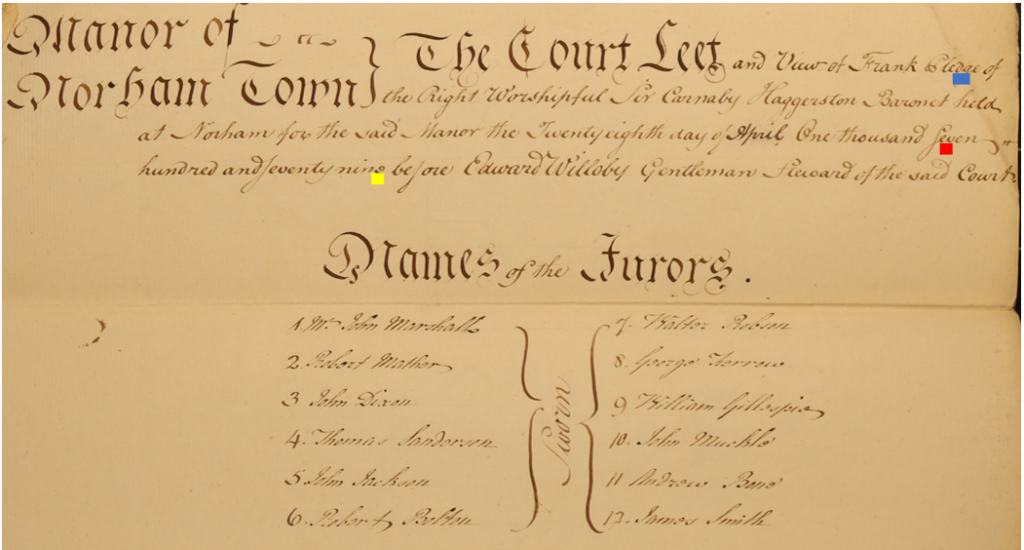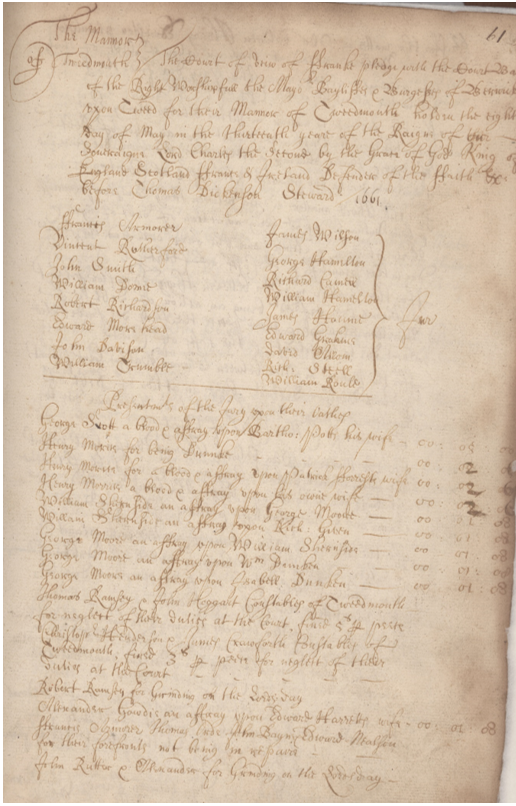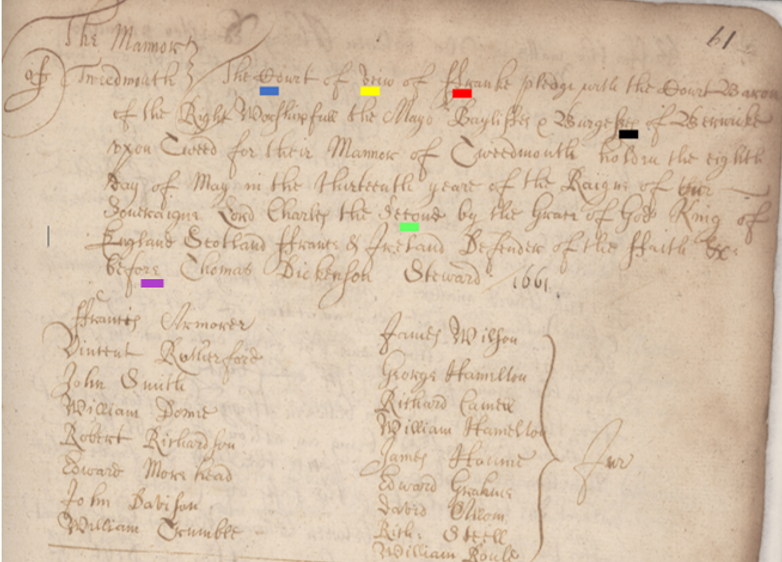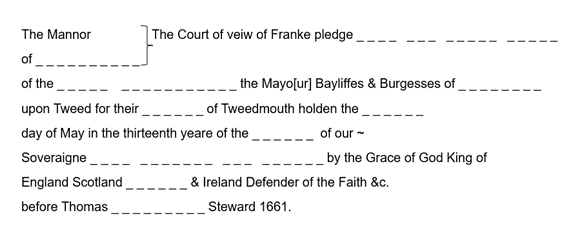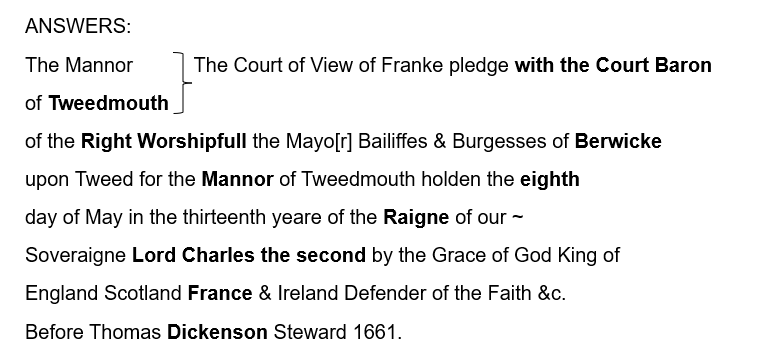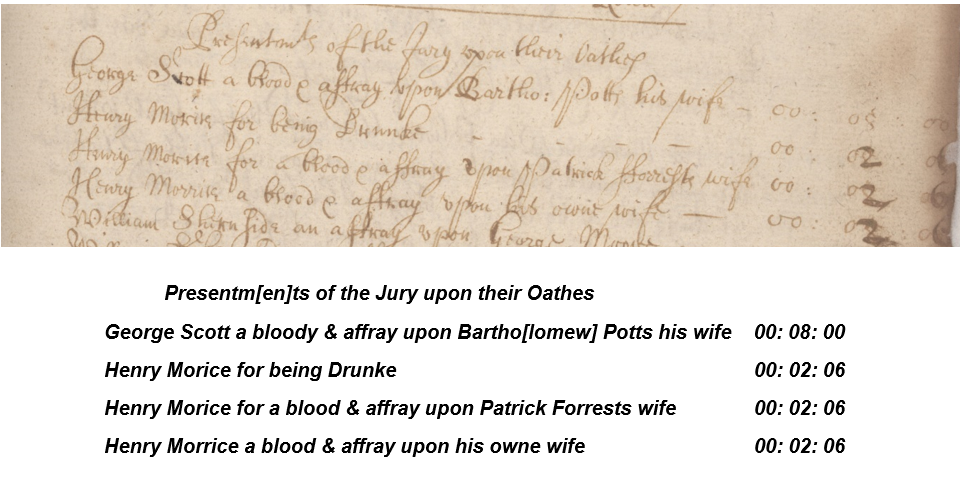Everyday Life in a Northumbrian Manor
All Manor of Things: An introduction to manors and their documents
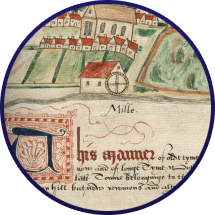
Court Rolls and Court Books
Court rolls or Court Books are an important manorial record and reveal what was discussed at each manor court. They follow a “set format” and use particular wording throughout which tends to be the same in all documents whether 17th or 19th century.
Tip
Looking at more recent documents first and knowing what is included in each section helps when trying to read older documents in a less legible script.
Let’s start with this Norham Town manor court roll dated 1779 (BRO 510-71).
This document can be divided into different sections. These include:
- The name of the manor
- The type of court
- The name of the lord/lady of the manor
- The name of the steward
- The date
- A list of jurors
- Business of the court including cases (presentments)
Look back at the Manorial Documents section for the full list if you are not sure about the layout of the document.
Before trying to find the information listed above, let’s look at individual words and the style of writing. This document has been written in italic and most of the letter forms are very similar to today. However, there are some letters which are worth noting in this example below.
- “d” (line 1, underlined in blue). The upward stroke slopes to the left compared to being upright today. This becomes more pronounced in earlier forms of handwriting.
- “s” (line 3, left of the red square). This goes below the line and can be confused with “f”. Known as a long “s” it is very common and when written as “ss”, the first one is usually a long “s” followed by a short version, similar to our modern “s”. Context can usually help to establish which letter is being used.
- “e” (line 4, underlined in yellow). This is known as theta “e” or a backwards “e”. In some documents it can appear a bit like an “o” but it tends to have a line through it or a slight knob on the top. Again, use the context of the other letters in the word to help work it out.
Activity – Give it a go
Test your knowledge using what we know about the layout (diplomatic) of court rolls so far!
The questions can be found in the first drop down and the answers in the second.
- What type of court is the document from?
- What is the name of the lord?
- What date is the document from?
- What is the name of the steward?
- What is the name of juror number 3?
- What type of court is the document from?
Court Leet and a View of Frankpledge - What is the name of the lord?
Sir Carnaby Haggerston Baronet - What date is the document from?
28th April 1779 - What is the name of the steward?
Edward Willoby - What is the name of juror number 3?
John Dixon
Presentments
Below this information can be found the presentments (cases). Have a go at transcribing this one. The image can be found in the first drop down and the answers in the second.
Tweedmouth Manor Court Roll
Now let’s compare this with an earlier court roll from 8 May 1661 (BA-M-1-1-1-p.54), to see if the same wording appears in the same place. This has been written into a court book.
Let’s look at the handwriting first. In this document, which is over 100 years older, there are some examples of secretary letter forms which are different to italic, and unlike modern letter forms.
Some typical secretary letter formats have been underlined.
- “C” (line 2, underlined in blue). This is a capital “C”, which is often described as a “hot-cross bun”.
- “c” (line 6, underlined in green). There is a lower case “c” which isn’t curved. It is an important letter to learn as it looks like a modern “r”. These are not to be confused.
- “r” A secretary “r” has two formats – a “2” form found in “Court” (line 2 underlined in blue) and a squashed “w” format (line 2, underlined in red).
- “ff” (line 2 underlined in red). This represents a capital “F”.
- “v” (line 2, underlined in yellow). This letter should be familiar – see section 4 on roman numerals. This “v” has a long left-hand stem and the curled right-hand stem. This word has been spelt “veiw” and not as it would be spelt today (“view”).
- “e” (line 2, underlined in yellow). This is a flat-topped variety of “e”. The theta format is also found as well as one like a backwards “3” (line 8, underlined in purple).
- “ss” (line 3, underlined in black). This is an example of a long “s” followed by a shorter version – last few letters of “Burgesses”.
Activity - Fill in the missing words
Have a go at filling in the blanks in this partial transcript which is taken from the image above. The dashes denote the number of missing letters – remember to use the spelling the scribe has used, don’t translate the words to the modern spelling.
Presentments
Next there is a list of sworn jurors and then the presentments at the Court. Let’s look at the presentments which will deal with individual cases but will include words founds in most manor court documents.
Here Henry Morice, probably Morris today, has been called forward for a number of offences! Note that his name is spelt differently in the third entry. Standardised spelling is relatively modern, so don’t expect it in older documents. Names were often spelt as they sounded and in several different ways, even within the same document!
The fines are noted in Arabic numerals. The format is usually pounds, shillings and pence (li s d) – see the section currency – and although these symbols do not appear, it is clear what they are. The first fine is 8 shillings, and all the others are 2 shillings and 6 pence.
Tip
If you find the presentments difficult to read, look back at the last section on reading documents. As the general format of a manor court roll/book is the same, identify words and letter forms in the heading which doesn’t tend to change. Use this to create your own alphabet for the document and keep remembering to scan the whole document for other examples of the same letter, particularly in words you have worked out.
It’s worth trying to draw the difficult letters like “c”,” r” and “e” on some note paper – old and present day versions. This provides an easy reference tool.
Common abbreviation - Accon
You do also need to be aware of abbreviations in manorial presentments, particularly “accon” or “accion”.
An “action of debt” and an “action of trespass” are two common phrases found in manorial presentments, with “action” denoting that someone has been brought forward for these crimes.
The word “action” is usually either written out in full, but spelt “accion”, or abbreviated to “accon”. Note in both cases, it is spelt with two “c”s rather than “ct”.
There is an example of this below (accion is underlined in the second line):
Sometimes you may find that there is an abbreviation mark (a line) above the word (see tips for reading the documents), but do not rely on this as it is not always included.
The manor court rolls/books are the most difficult to read and interpret, however, by using the tips and information above, it should be easier.



